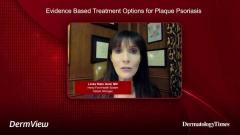
Plaque Psoriasis Treatment: Tapinarof Tolerability
Experts in plaque psoriasis provide an overview of the itch response and tolerability profile of tapinarof.
Episodes in this series

LindaStein Gold, MD: Nice separation. What was nice about both of these drugs was the good reproducibility of the data. As you mentioned, there is a nice separation between the active and the vehicle. This is a cream formulation. Did it work in itching?
Jennifer Soung, MD: Again, there is a nice relief in itch. I use it as a marker, or I tell my patients, "What you're going to notice first is hopefully a relief in your itching. And you know that this medicine is starting to work for you." So you can start to see that the lines between the active group, tapinarof, between placebo or vehicle group separate at around week 2.
LindaStein Gold, MD: That's nice. Now, this is another nonsteroidal option. They did treat these patients in both phase 2 and phase 3, so we're allowed to use this in sensitive areas. This means skinfold, face, and groin. Was this okay for a sensitive area, or was there too much stinging, or burning?
Jennifer Soung, MD: Great, there are nice results. We asked patients about all of these areas in the study. We asked about that gluteal fold, the underarms, the face, the genital areas, underneath the breast, the neck, and any other skin fold. The tolerability was great. When I look at the feedback from the patients, you're seeing very low rates of any sort of localized skin reaction.
LindaStein Gold, MD: Now, when we talk about the adverse effect profile, the 2 adverse effects that jumped out more than the others are the folliculitis, which occurred in up to 20% of patients. This was generally mild or moderate, and most of it resolved while on treatment without any intervention. Is this something that you have seen in clinical trials, or in actual practice?
Jennifer Soung, MD: I'm glad you bring that up because it's so important for us to be transparent with our patients. With certain medications, we know that there can be adverse effects, so they're not surprised or concerned if it does happen to them. I did see a few cases. Often, these patients were the ones who were super responders too, but there was no way for me to predict which patients. I'm not sure if folliculitis and contact derm is the perfect term, but I lump them together. It's a localized skin reaction that usually occurs in the area of the application. I tell my patients to just temporarily stop if it does happen. And in some cases, it almost looks like a keratosis pilaris-like reaction.
LindaStein Gold, MD: I agree with you. I've done the same thing and I've seen it a few times. It's always been mild. I just say, "Don't treat that area, you continue to treat other areas that are not involved." Same thing with the contact dermatitis, which I have not seen. But the examples I have seen have been fairly mild and tend to resolve even just by not treating that particular area.
Jennifer Soung, MD: Exactly. Simply by just stopping the topical temporarily, the reaction will resolve.
Transcript edited for clarity
Newsletter
Like what you’re reading? Subscribe to Dermatology Times for weekly updates on therapies, innovations, and real-world practice tips.






















